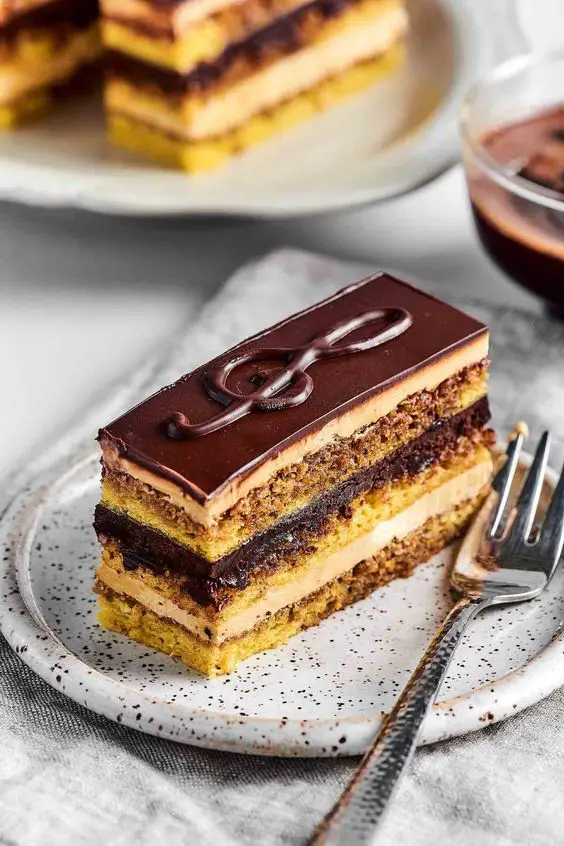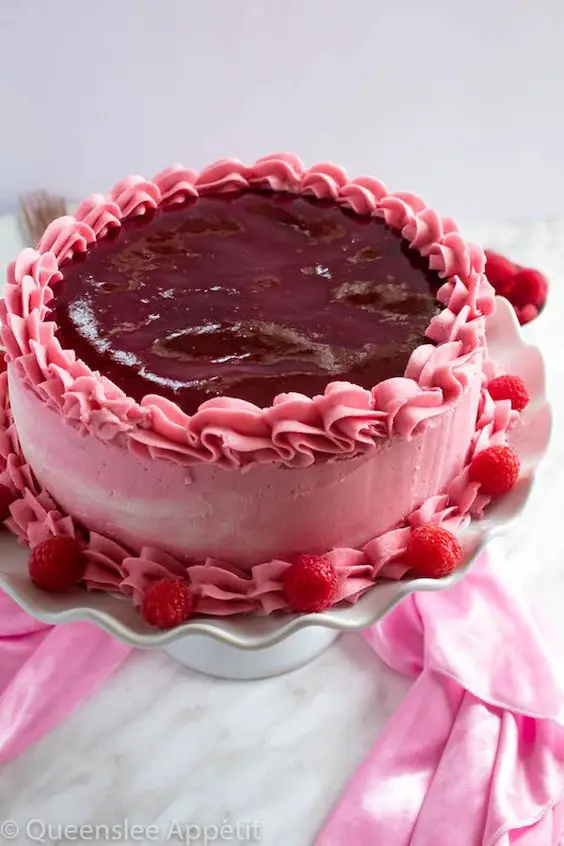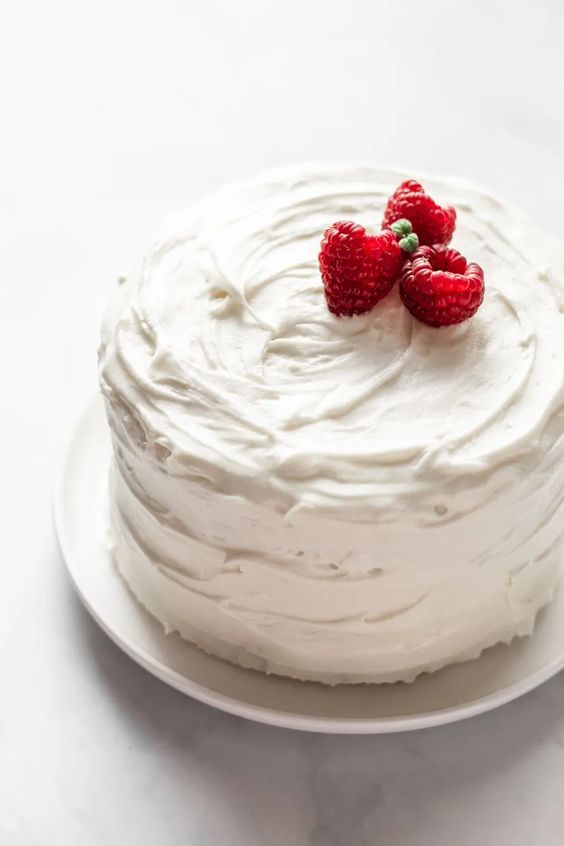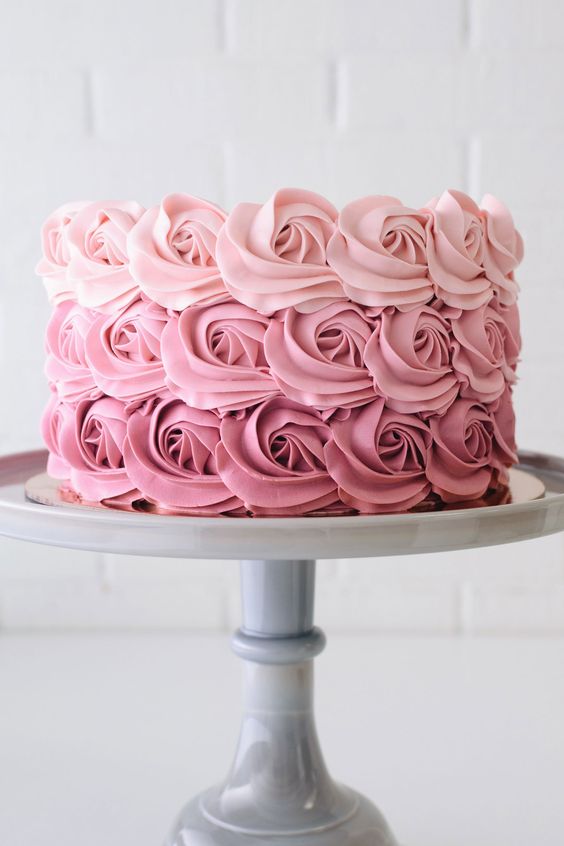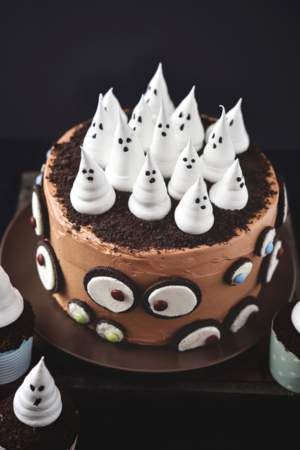Opera Cake, also known as “Gâteau Opéra” in French, is a luxurious and elegant dessert that hails from the world of French pastry. This exquisite cake is celebrated for its harmonious blend of textures and flavors, making it a favorite among dessert connoisseurs and a staple in high-end patisseries.
An Opera Cake typically consists of thin layers of almond sponge cake soaked in coffee syrup, layered with alternating fillings of coffee-flavored buttercream and rich chocolate ganache. The cake is then enrobed in a glossy chocolate glaze, creating a beautiful and indulgent finish. The name “Opera” is said to be inspired by its resemblance to the opulent, richly layered performances of the opera, mirroring the complexity and refinement of this delightful French dessert. With its balanced sweetness and layers of coffee and chocolate, Opera Cake is a true masterpiece of the pastry world, perfect for special occasions or to savor as an exceptional treat.
What is Opera Cake?
Opera Cake, also known as “Gâteau Opéra” in French, is a classic and sophisticated French dessert that combines a harmonious blend of flavors and textures. This delectable cake typically features the following components:
- Almond Joconde (Sponge Cake): The base of an Opera Cake is a thin layer of Joconde sponge cake. This sponge cake is made with almond flour and is known for its delicate and light texture.
- Coffee Syrup: The Joconde layers are often soaked in a coffee syrup, which infuses the cake with a rich coffee flavor. This syrup adds moisture and depth to the dessert.
- Coffee Buttercream: One of the key components of an Opera Cake is a coffee-flavored buttercream. This creamy filling is light and typically infused with coffee or espresso, imparting a delicious coffee aroma and taste.
- Chocolate Ganache: Another integral layer is a smooth and rich chocolate ganache. This ganache adds a luscious chocolate flavor and a contrasting texture to the cake.
- Chocolate Glaze: The entire cake is often coated with a shiny chocolate glaze, which gives the Opera Cake its elegant and glossy appearance. The glaze is made from a mixture of chocolate, butter, and sometimes cream.
Opera Cake is well-known for its precise, layered appearance, with alternating layers of Joconde, coffee syrup, coffee buttercream, and chocolate ganache. The cake is often finished with intricate chocolate decorations or powdered cocoa, adding to its aesthetic appeal. It’s a favorite in patisseries and is considered a symbol of French pastry artistry, offering a delightful balance of coffee and chocolate flavors.
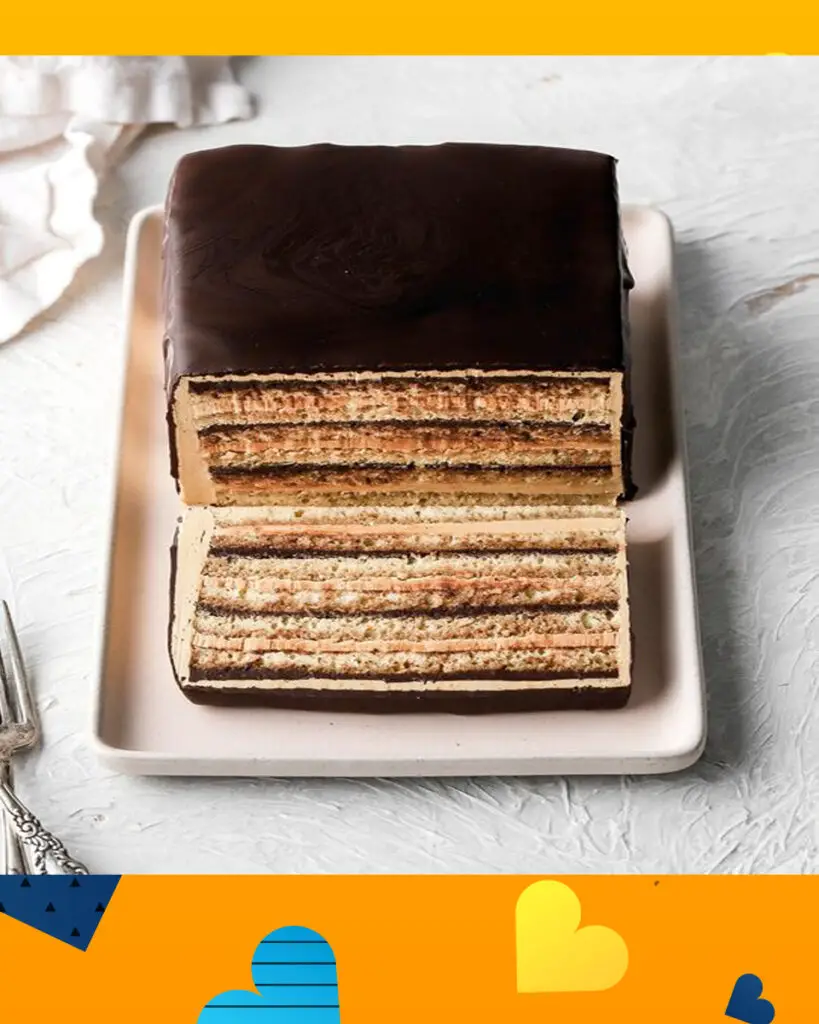
What are the key components of an Opera Cake?
The key components of an Opera Cake, also known as “Gâteau Opéra” in French, are:
- Almond Joconde (Sponge Cake): The base of an Opera Cake is a thin layer of Joconde sponge cake. This sponge cake is made with almond flour and is known for its delicate and light texture.
- Coffee Syrup: The Joconde layers are often soaked in a coffee syrup, which infuses the cake with a rich coffee flavor. This syrup adds moisture and depth to the dessert.
- Coffee Buttercream: One of the key components of an Opera Cake is a coffee-flavored buttercream. This creamy filling is light and typically infused with coffee or espresso, imparting a delicious coffee aroma and taste.
- Chocolate Ganache: Another integral layer is a smooth and rich chocolate ganache. This ganache adds a luscious chocolate flavor and a contrasting texture to the cake.
- Chocolate Glaze: The entire cake is often coated with a shiny chocolate glaze, which gives the Opera Cake its elegant and glossy appearance. The glaze is made from a mixture of chocolate, butter, and sometimes cream.
- Garnish: Opera Cakes are often garnished with decorative elements like chocolate shavings, cocoa powder, or chocolate decorations. These finishing touches add to the cake’s visual appeal.
The layering of these components creates the characteristic taste and texture of an Opera Cake. It’s a dessert known for its elegant and harmonious balance of coffee and chocolate flavors, making it a classic and beloved French pastry.
Why you will love Opera Cake?
- Sophisticated Flavor: Opera Cake is a dessert known for its exquisite and well-balanced flavors. The combination of coffee, chocolate, and almond in each layer creates a rich and sophisticated taste that appeals to a wide range of palates.
- Elegant Presentation: The meticulous layering and glossy chocolate glaze of an Opera Cake make it an elegant and visually stunning dessert. Its precise appearance is a feast for the eyes and adds a touch of sophistication to any occasion.
- Textural Harmony: Opera Cake is praised for its textural harmony. The layers of moist Joconde sponge, creamy buttercream, and smooth ganache create a delightful contrast of softness and creaminess.
- Perfect for Coffee Lovers: If you’re a coffee enthusiast, Opera Cake is a perfect choice. The infusion of coffee flavors in the syrup and buttercream offers a delightful coffee aroma and taste.
- French Pastry Excellence: Opera Cake is considered a masterpiece of French pastry. Enjoying it allows you to savor the artistry and culinary expertise that goes into creating such a refined dessert.
- Special Occasions: Opera Cake is often associated with special occasions and celebrations due to its elegance and complexity. It’s a dessert that can make any event feel more luxurious and memorable.
- Customization: While the classic Opera Cake is beloved, you can experiment with various flavor variations, such as different types of buttercream or alternative syrups, to create a dessert that suits your personal taste.
- Aesthetic Pleasure: Creating an Opera Cake can be a labor of love, and the process itself can be satisfying. It’s a dessert that rewards precision and patience, making it a great choice for avid bakers.
- Cultural Appreciation: Enjoying an Opera Cake allows you to savor a slice of French culinary culture and history. It’s a dessert that represents the refinement and artistry of French patisserie.
In summary, Opera Cake is a delightful dessert that combines exquisite flavors, stunning presentation, and a touch of French elegance. Whether you’re a coffee lover, an admirer of culinary craftsmanship, or someone who appreciates a beautifully composed dessert, Opera Cake is sure to charm your palate and senses.
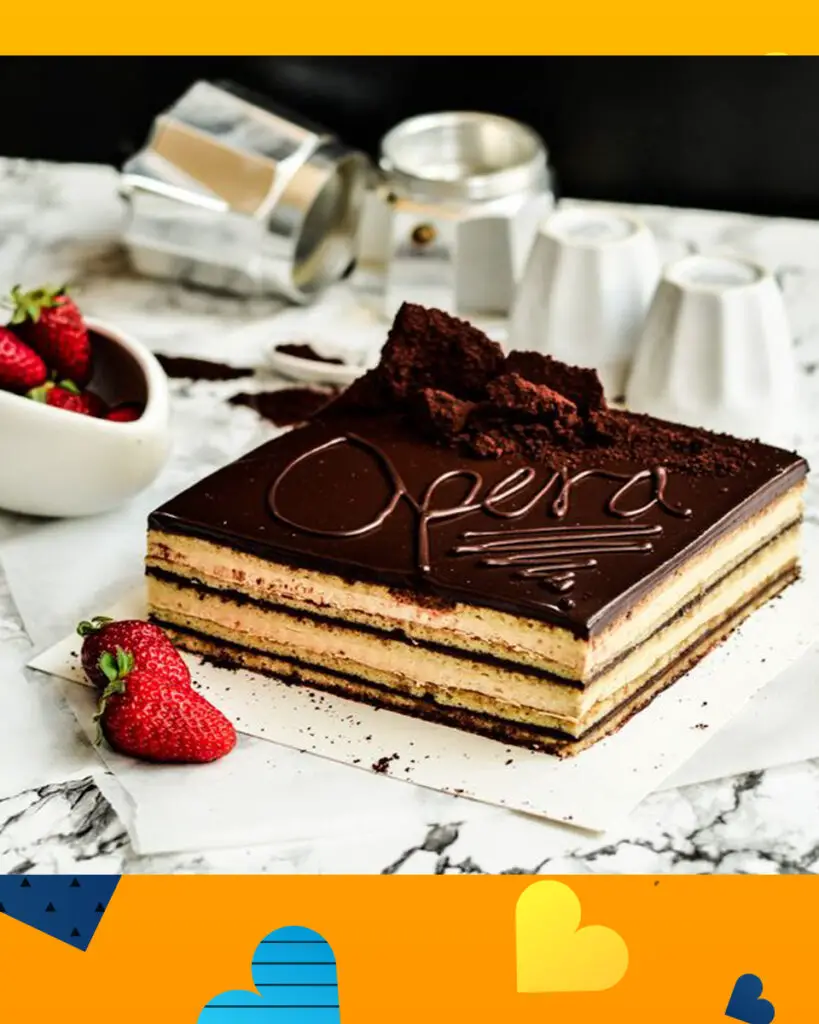
Opera Cake Recipe
Ingredients:
For the Almond Joconde (Sponge Cake):
- 75g (2/3 cup) almond flour
- 75g (2/3 cup) powdered sugar
- 3 large eggs
- 3 large egg whites
- 20g (2 tablespoons) granulated sugar
- 20g (2 tablespoons) all-purpose flour
- 25g (2 tablespoons) unsalted butter, melted
- 1/2 teaspoon almond extract
For the Coffee Syrup:
- 120ml (1/2 cup) strong coffee, brewed and cooled
- 30g (2 tablespoons) granulated sugar
- 2 tablespoons coffee liqueur (optional)
For the Coffee Buttercream:
- 150g (2/3 cup) unsalted butter, softened
- 150g (1 1/4 cups) powdered sugar
- 1-2 tablespoons instant coffee powder, dissolved in a small amount of hot water and cooled
- 1-2 tablespoons coffee liqueur (optional)
For the Chocolate Ganache:
- 150g (5.3 ounces) dark chocolate, finely chopped
- 150ml (2/3 cup) heavy cream
For the Chocolate Glaze:
- 100g (3.5 ounces) dark chocolate, finely chopped
- 50ml (3 tablespoons) heavy cream
- 1 tablespoon unsalted butter
Instructions:
1. Prepare the Almond Joconde:
- Preheat your oven to 350°F (180°C). Grease and line a baking sheet with parchment paper. In a mixing bowl, combine almond flour and powdered sugar. Add the whole eggs and mix until smooth.
- In a separate bowl, beat the egg whites until they form soft peaks, gradually adding granulated sugar. Fold the egg whites into the almond mixture. Gently fold in the flour, melted butter, and almond extract.
- Spread the batter evenly onto the prepared baking sheet and bake for 12-15 minutes, or until the sponge is lightly golden and springs back when touched.
2. Prepare the Coffee Syrup:
- In a small saucepan, combine the brewed coffee and granulated sugar. Heat over low heat until the sugar dissolves. Remove from heat and stir in the coffee liqueur (if using). Let it cool.
3. Make the Coffee Buttercream:
- In a mixing bowl, beat the softened butter until creamy. Gradually add the powdered sugar and dissolved coffee. Continue to beat until smooth. If desired, add coffee liqueur to taste. Set aside.
4. Prepare the Chocolate Ganache:
- Place the finely chopped dark chocolate in a heatproof bowl. In a saucepan, heat the heavy cream until it begins to simmer. Pour the hot cream over the chocolate and stir until the mixture is smooth. Let it cool.
5. Assemble the Opera Cake:
- Cut the Joconde sponge into equal-sized rectangles or squares to fit your desired cake size. Place one layer of sponge on a serving platter or cake board.
- Brush the coffee syrup over the sponge layer to moisten it. Spread a portion of the coffee buttercream over the sponge.
- Add another layer of sponge, repeat the syrup and buttercream steps, and continue layering until you’ve used all the sponge and coffee buttercream. Finish with a layer of sponge.
- Pour the chocolate ganache over the top layer, allowing it to drip down the sides to cover the entire cake. Refrigerate the cake for at least an hour to set the layers.
6. Prepare the Chocolate Glaze:
- In a saucepan, combine finely chopped dark chocolate, heavy cream, and unsalted butter. Heat over low heat until the mixture is smooth. Let it cool slightly.
7. Glaze the Cake:
- Pour the chocolate glaze over the chilled cake, ensuring it covers the entire surface. Use a spatula to create a smooth and glossy finish. Refrigerate for several hours or overnight to set.
8. Serve the Opera Cake:
- To serve, use a sharp, hot knife to cut clean slices. Enjoy your homemade Opera Cake, an elegant and delicious French pastry!
This Opera Cake recipe is a classic version, but you can customize it with variations in flavor and decoration to suit your preferences and creativity.
Nutrition information
The nutrition information for Opera Cake can vary depending on the specific recipe and portion sizes. Below is an approximate guideline for the nutritional content of a classic Opera Cake. Keep in mind that actual values may vary based on the ingredients and measurements used:
Serving Size: 1 slice (approximately 1/8 of an 8-inch square Opera Cake)
Calories: Approximately 350-400 calories per slice
Protein: About 3-5 grams
Carbohydrates: Approximately 35-45 grams
Fat: Around 22-30 grams
Saturated Fat: About 12-16 grams
Sugar: Approximately 30-40 grams
Fiber: Minimal, typically less than 1 gram
Cholesterol: Around 70-90 milligrams
Sodium: Approximately 20-40 milligrams
Please note that these values are approximate and can vary based on the specific recipe, the size of the slice, and any additional ingredients used. If you have specific dietary concerns or requirements, it’s advisable to calculate the exact nutrition information based on the ingredients and measurements you use in your homemade or store-bought Opera Cake. Additionally, commercial variations of Opera Cake may have nutrition labels available on their packaging for more accurate information.
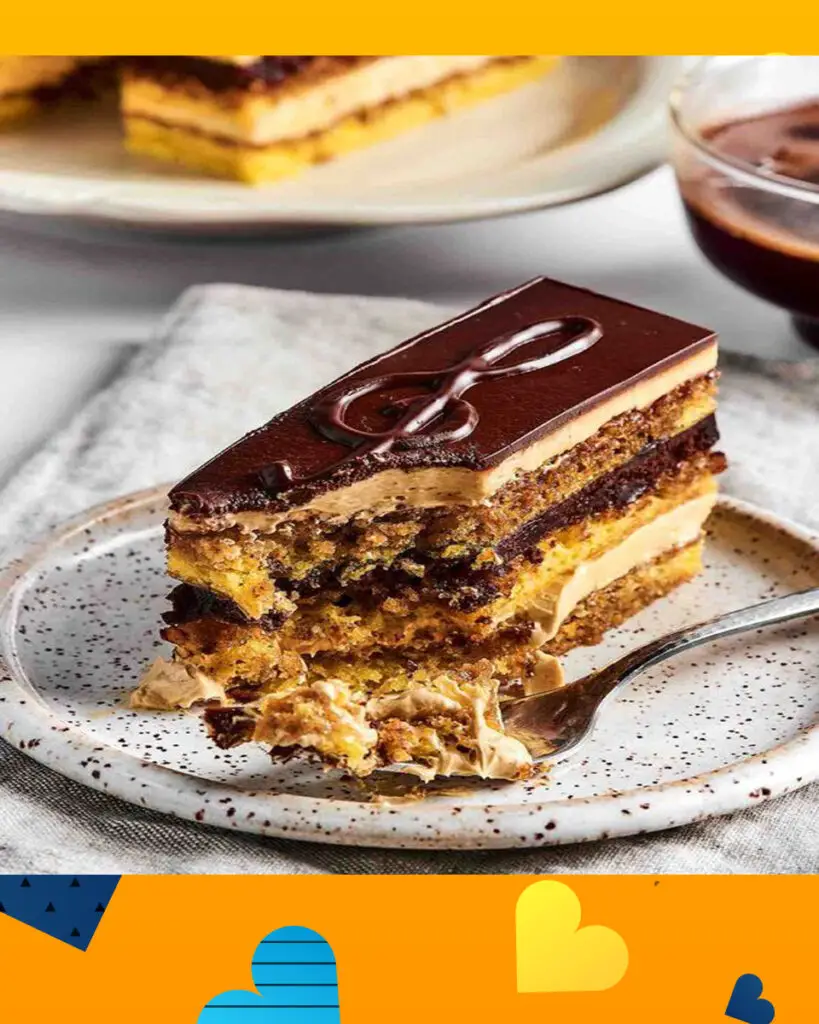
Tips to make perfect Opera Cake
Making a perfect Opera Cake can be a challenging but rewarding endeavor. Here are some tips to help you achieve a flawless result:
1. Precise Measurements:
- Ensure that you measure your ingredients accurately. Precision is key to maintaining the correct balance of flavors and textures.
2. Organize Your Workspace:
- Before you start, gather all your ingredients and equipment. Having everything organized will make the process smoother and more efficient.
3. Meticulous Joconde Baking:
- When baking the Joconde sponge, be careful not to overbake it. The sponge should be light and slightly springy to the touch. Overbaking can result in a dry sponge.
4. Even Layering:
- When assembling the layers, ensure that each layer is even and uniform. Use a ruler or measuring tape to achieve consistency.
5. Proper Syrup Soaking:
- When applying the coffee syrup to the sponge layers, don’t oversaturate them. A light brushing of syrup is sufficient to add flavor and moisture.
6. Temperature Control:
- Keep the buttercream and ganache at the right temperature while assembling the cake. They should be spreadable but not too soft. If needed, refrigerate them briefly to firm up.
7. Chill Between Layers:
- After applying each layer, chill the cake in the refrigerator for a short time to set the buttercream and ganache. This helps maintain the structural integrity of the cake.
8. Sharp, Hot Knife:
- When cutting the finished Opera Cake, use a sharp, hot knife. Dip the knife in hot water and wipe it dry before each cut to achieve clean, smooth slices.
9. Chocolate Glaze Consistency:
- Ensure that the chocolate glaze is at the right consistency when you pour it over the cake. It should be pourable but not too thin. Use a spatula to help spread it evenly.
10. Refrigeration for Flavor:
- Opera Cake benefits from a period of refrigeration (several hours to overnight) to allow the flavors to meld and for the layers to set.
11. Customize Flavors:
- Feel free to customize the flavors to your liking. You can experiment with different extracts, liqueurs, or variations of buttercream to create a unique Opera Cake.
12. Decorate Thoughtfully:
- If you choose to decorate the cake, do so thoughtfully. Chocolate shavings, cocoa powder, or edible gold leaf can add a beautiful touch.
13. Practice Patience:
- Making Opera Cake can be a meticulous process that requires patience and attention to detail. Be patient and take your time to achieve the best results.
Remember that practice makes perfect, and even if your first attempt doesn’t turn out flawlessly, you’ll learn and improve with each one. An Opera Cake is a true masterpiece of French pastry, and the effort is well worth the exquisite taste and presentation.
How to serve Opera Cake
Serving Opera Cake is a delightful experience, and it’s usually presented with a touch of elegance. Here’s how to serve Opera Cake:
1. Clean Slices:
- Use a sharp, hot knife to cut clean slices of Opera Cake. To ensure the slices are neat and smooth, dip the knife in hot water and wipe it dry before each cut.
2. Presentation Plates:
- Place each slice of Opera Cake on individual dessert plates. The cake’s elegant appearance deserves individual servings to showcase its beauty.
3. Garnish Creatively:
- Add decorative touches to each plate. You can garnish the plate with a light dusting of cocoa powder or powdered sugar for a classic look. Alternatively, add chocolate shavings or a cocoa design on the plate.
4. Complementary Elements:
- Opera Cake pairs well with a variety of accompaniments. A dollop of whipped cream or a small scoop of vanilla ice cream can add a creamy contrast to the cake’s rich flavors. Fresh berries or a fruit compote can also be a delightful addition.
5. Coffee or Dessert Wine:
- Consider serving Opera Cake with a hot cup of coffee, espresso, or a dessert wine like a late-harvest Riesling or a Tawny Port. The coffee flavors in the cake complement coffee-based beverages, while the sweetness of a dessert wine harmonizes with the dessert’s richness.
6. Elegant Table Setting:
- If you’re serving Opera Cake at a special occasion or celebration, create an elegant table setting. Use fine china, glassware, and silverware to enhance the experience.
7. Inform Your Guests:
- Opera Cake is a sophisticated dessert, so inform your guests about its flavors and components. Share the story and complexity of the cake to enhance their appreciation.
8. Enjoy Slowly:
- Opera Cake is a dessert to be savored. Encourage your guests to take their time, enjoy each layer, and savor the intricate flavors and textures.
Opera Cake is a dessert that elevates any occasion, and its presentation is an integral part of the experience. By serving it with attention to detail and a touch of sophistication, you’ll create a memorable and delicious dessert moment for your guests.
How to store Opera Cake
Storing Opera Cake properly is essential to maintain its freshness and quality. Here’s how to store Opera Cake:
1. Refrigeration:
- Opera Cake should be stored in the refrigerator to keep it fresh. Cover the cake with a cake dome, cake box, or an airtight container to protect it from absorbing other odors in the fridge.
2. Separation:
- If you need to stack or store multiple slices of Opera Cake, separate them with parchment paper or wax paper to prevent sticking and to maintain the cake’s appearance.
3. Avoid Freezing:
- While Opera Cake can be refrigerated, it’s not recommended to freeze it. Freezing can alter the texture and taste of the cake, particularly the delicate layers.
4. Keep Chilled:
- Make sure the cake is kept at a consistent and cool temperature in the refrigerator, ideally between 32°F to 40°F (0°C to 4°C). This prevents the layers from becoming too soft or losing their structure.
5. Airtight Seal:
- Ensure that the cake container has an airtight seal to prevent the cake from drying out and absorbing any unwanted fridge odors.
6. Minimal Moisture:
- Opera Cake is sensitive to moisture, so avoid placing it near containers of moist foods in the fridge to maintain the cake’s texture.
7. Consume Promptly:
- For the best taste and texture, Opera Cake is ideally enjoyed within a few days of preparation. While it can be stored in the refrigerator for several days, its quality may diminish over time.
8. Allow to Come to Room Temperature:
- When you’re ready to serve the Opera Cake, remove it from the refrigerator about 30 minutes to an hour before serving to allow it to come to the desired serving temperature.
Proper refrigeration and storage practices will help maintain the freshness and deliciousness of your Opera Cake until it’s time to be enjoyed.
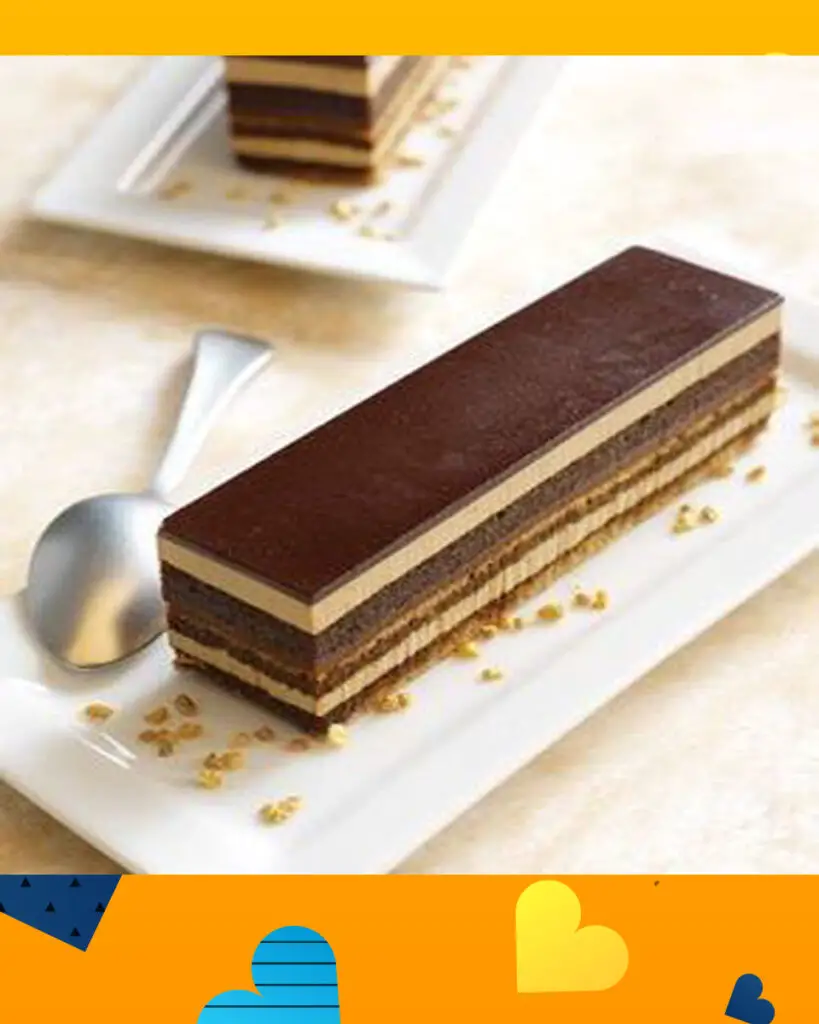
FAQ’s
1. What is the origin of Opera Cake?
- Opera Cake, or “Gâteau Opéra,” is believed to have originated in France. It’s a creation of French pastry chefs and is renowned for its exquisite layers and flavors.
2. What are the key components of an Opera Cake?
- An Opera Cake typically consists of almond Joconde sponge cake, coffee syrup, coffee buttercream, chocolate ganache, and a chocolate glaze. These elements come together to create its distinctive taste and texture.
3. How can I prevent my Joconde sponge from becoming dry or rubbery?
- To prevent a dry or rubbery sponge, avoid overbaking the Joconde. Follow the recommended baking time and keep a close eye on it. You can also brush the sponge with coffee syrup to add moisture.
4. What can I do if my Opera Cake layers are not staying in place?
- To ensure that the layers stay in place, make sure each component is well-chilled before assembly. This will help the buttercream and ganache firm up, providing stability. You can also use a cake collar or acetate strips to maintain the layers’ alignment.
5. How do I get a smooth and glossy chocolate glaze on my Opera Cake?
- For a smooth and glossy glaze, it’s essential to make sure your ganache and glaze are at the right temperature when you pour them. Allow the ganache to cool slightly, but not too much, before glazing. You can also use a spatula to help spread the glaze evenly.
6. Can I make an Opera Cake in advance?
- Yes, you can make an Opera Cake in advance. It’s actually recommended to allow the flavors to meld. Store the cake in the refrigerator and remove it about 30 minutes to an hour before serving to allow it to come to the desired serving temperature.
7. How should I store leftover Opera Cake?
- Leftover Opera Cake should be stored in the refrigerator in an airtight container. It can be kept for several days and still remain delicious.
8. Can I freeze Opera Cake?
- Yes, you can freeze Opera Cake. Wrap it tightly in plastic wrap and store it in an airtight container in the freezer. To thaw, place it in the refrigerator overnight.
9. What are some common variations of Opera Cake?
- Variations of Opera Cake can include different flavors of buttercream, such as mocha, hazelnut, or caramel. You can also experiment with alternative syrups, like flavored liqueurs or simple syrup with added extracts.
10. How can I prevent my glaze from cracking when slicing the cake? – To prevent the glaze from cracking, use a sharp, hot knife when slicing the cake. Dip the knife in hot water and wipe it dry before each slice. This will help you achieve clean and smooth cuts.
Opera Cake can be a challenging but rewarding dessert to make. These FAQs and troubleshooting tips should help you create a delicious and visually stunning treat.
Happy baking!

